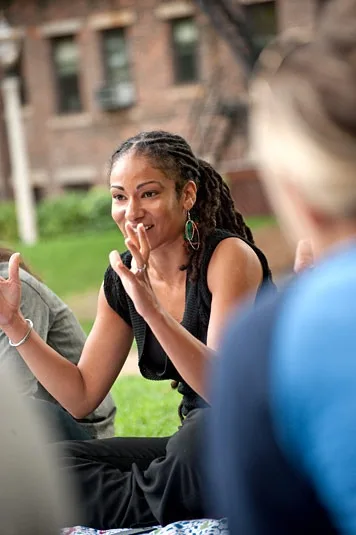 Ruha Benjamin is an interdisciplinary scholar who examines the relationship between science, technology, medicine, and society. She is a professor of African American studies at Princeton University and is the author of People’s Science: Bodies and Rights on the Stem Cell Frontier (Stanford University Press 2013), in which she asks questions about who is included and excluded in scientific research initiatives. Dr. Benjamin was recently an American Council of Learned Societies fellow at the Harvard Kennedy School’s Science, Technology, and Society Program where she started a new project on how genomic science in different countries reflects, reinforces, and sometimes challenges racial and caste hierarchies. She received a PhD in sociology from the University of California-Berkeley and completed a postdoctoral fellowship at UCLA’s Institute for Society and Genetics.
Ruha Benjamin is an interdisciplinary scholar who examines the relationship between science, technology, medicine, and society. She is a professor of African American studies at Princeton University and is the author of People’s Science: Bodies and Rights on the Stem Cell Frontier (Stanford University Press 2013), in which she asks questions about who is included and excluded in scientific research initiatives. Dr. Benjamin was recently an American Council of Learned Societies fellow at the Harvard Kennedy School’s Science, Technology, and Society Program where she started a new project on how genomic science in different countries reflects, reinforces, and sometimes challenges racial and caste hierarchies. She received a PhD in sociology from the University of California-Berkeley and completed a postdoctoral fellowship at UCLA’s Institute for Society and Genetics.
SCI: Kicking things off with People’s Science, how did you get started on that project and what were some of the biggest takeaways that you got from doing that examination and writing the book?
RB: My book grew out of my dissertation, which I completed as a graduate student at UC-Berkeley.
When we think about the stem cell research initiative, on the surface it seems like a democratic process where voters approved public funding of research. But there were all kinds of implicit biases and forms of exclusion that we should try to be attentive to and address in future initiatives.
In the case of the stem cell initiative, it was a public initiative, but there was a particular vision of “the public” that [its leaders] had in mind. It assumed a public where there were a lot of patient advocates who already understood and believed in the importance and the potential of stem cell research.
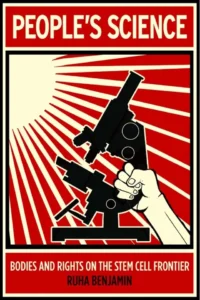 And there really wasn’t a space for anyone who questioned that potential or who didn’t understand enough about the science to support it, to engage the process in a meaningful way.
And there really wasn’t a space for anyone who questioned that potential or who didn’t understand enough about the science to support it, to engage the process in a meaningful way.
For example, there was a point where one of the state legislators was trying to ensure that all of the royalties that might come from state-funded stem cell research would feed back into the health system and that the [treatments developed through stem cell research] would be widely available, and not only for the rich. Prominent stem cell advocates really fought against that saying it would slow the science.
This is a laissez-faire approach to research, where we say it should have little regulation and accountability to issues of equity. We don’t want to over-regulate and hamper the science, but there has to be a middle ground where we can build in mechanisms that ensure that the broadest possible public is able to benefit from medical advances.
In the book, I have a chapter about sickle cell disease. One of the earliest stem cell therapies was for sickle cell anemia, which in the US predominantly affects African-Americans (it also affects other populations around the world.)
The African-American community has a long history with sickle cell treatments. Prior to stem cell research, promise after promise had been made about how “we’re going to find a way to treat it,” and people have consented to experimental treatments that had very negative outcomes.
And the science community [has a habit of] not taking that history into account and expecting the African-American community to just jump on board.
SCI: How do scientists react when you’re going around asking them all these questions?
RB: I’ve met with a lot of reluctance from both scientists and clinicians/healthcare providers. A lot of times, unfortunately, any questioning is cast as “anti-science.”
Asking the kind of questions I raise, is usually interpreted as being opposed to what [the scientists] are doing….as opposed to making it more politically and socially robust.
I’ve had people give me the cold shoulder or accuse me and the academic fields I work in as being “nay-sayers.” It’s often chalked up to people who question science, “not really getting it, because obviously if you understood what we were trying to do, you would support it.”
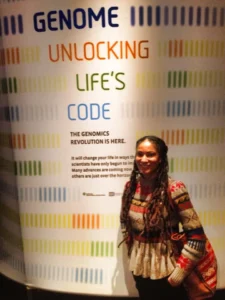 On the other hand, I’ve been really surprised by stem cell researchers and by genomicists who are really supportive and who are looking to collaborate, who are trying to go slower in their work and build in reciprocity between the researchers and the public. Because the public not only potentially benefits from medical breakthroughs, but are needed as a source of tissue samples, it can’t be a one-way interaction in which non-scientists are just waiting for “trickle-down” biomedicine to reach them.
On the other hand, I’ve been really surprised by stem cell researchers and by genomicists who are really supportive and who are looking to collaborate, who are trying to go slower in their work and build in reciprocity between the researchers and the public. Because the public not only potentially benefits from medical breakthroughs, but are needed as a source of tissue samples, it can’t be a one-way interaction in which non-scientists are just waiting for “trickle-down” biomedicine to reach them.
Often researchers need people to be on board in order to do their basic science in the first place. It creates an incentive for researchers to pay more attention, not only to ethical issues, but to political and economic issues as well.
I think that in the US, we have this huge field of bioethics, that often takes on the role of “clearing the path” so that scientists can do their work, as opposed to talking back to the scientists and challenging them to be more self-reflective in their approach to human subjects research.
I don’t see myself as a bioethicist. I’m more interested in biopolitics and the power dynamics involved in the research context.
In southern Africa, I found this community of scientists who are interested not just in taking tissue that they need to build their gene databases and their biobanks but also making the science more responsive to public concerns about power and inequality.
Unfortunately, the incentive structure for career advancement is really flimsy in terms of encouraging more scientists to connect with communities and allow the concerns people raise to shape their approach to research.
SCI: Do you ever notice any cultural differences within the scientific community? Do you get different reactions from the medical clinicians and the basic research people?
RB: Yes. For example, when I met with the head clinician at an urban teaching hospital, he was even more critical of the research wing of the institution than I was — in part, because he was invested in the long term care of his patients. He had a set of patients who were affected by sickle cell anemia, many of whom he had known since they were born who were now teenagers, so he was skeptical about the careerism of some researchers who he thought wanted to make a name for themselves in terms of sickle cell treatments and breakthroughs.
He was reluctant to introduce his patients to experimental treatments if he felt these could endanger their health, because he wasn’t sure that the researchers had his patients’ best interests at heart.
SCI: What are some of the most common misconceptions you encounter when you’re explaining all of this to other random people?
RB: It depends on who that random person is. So if that random person is someone whose career and livelihood and sense of self is really tied to an idea of “science equals progress,” then a lot of the things I’m saying may be seen as threatening or misguided.
The relationship between science and the public is often thought of as “We need to make them more scientifically literate — we need to make them more like us,” as opposed to questioning what our assumptions are.
SCI: You mentioned in your website bio that you moved around a lot between different countries and different cultures as a kid. How has that influenced what you study?
RB: In terms of geography, I was born in India. My mom is of Persian background but she grew up in India, and my dad is African-American. When I was about three, we moved to south central Los Angeles, and I grew up mostly with my dad’s side of the family.
We moved around every six or seven years — to South Carolina when I was nine, the Marshall Islands when I was fourteen, then I went to a boarding school in southern Africa, and came back to the states for college.
That travel and the different backgrounds I have experienced have made me really interested in and critical of the social categories we live our lives by. From a young age, I’ve been really sensitive to the power of social categories, and I noticed that what people think of as “natural” ways to differentiate people changes when you move across borders.
When I went to Swaziland in southern Africa for boarding school, I became more aware of how South African racial categories were different from US census categories. Walking around there, I fell into the “colored” category, but in the US, because of the one-drop rule, I qualified as “black.” So it was interesting to me that you could get off a plane and be categorized and treated differently.
For me, it’s not enough to recognize that these are illusory categories. I think it’s important to think about the effects these distinctions have on people’s life chances, and on their health and educational outcomes. It’s important to recognize that the things we “make up” as a society have real power, and that we can’t just wish them away.
As so as a graduate student, I became more interested in the role of science in classifying people. At first, I was concerned about [categories like race, gender, ethnicity, etc.] because of the power of social hierarchies. But then I also became interested in how science potentially challenges them or complicates our folk understandings of human difference.
SCI: Do you mind if I ask why you moved around so much as a kid?
RB: Both of my parents were in education. Their jobs involved helping start different educational programs. It was kind of like a military upbringing, but with words like “curriculum” and “pedagogy” always floating around the house.
I have a vivid childhood memory of sitting next to a chalkboard on my porch in LA and giving out little squares of paper to all the neighborhood kids with math problems on it for fun…. So I had a very positive relationship with education in terms of work being play, blurring the lines between the two.
And I think my love of asking questions, never being satisfied with someone else’s explanation, the desire to find things out for myself, grew out of this childhood experience. One of the core principles of my family’s religion — we practice the Baha’i faith — is the independent investigation of the truth. In the Baha’i faith, you don’t just accept what someone else is telling you, you go out and find out for yourself!
SCI: When you were going to college, what started to draw you toward sociology?
RB: When I went to college, I went in as a drama major with a minor in child development and within the first month, I switched to sociology with a minor in creative writing. For me, what really drew me to sociology from drama, is I realized that I love to know what’s behind-the-scenes, sometimes even more than seeing the movie. I like to know how things are put together.
I look at our social reality and wonder how things got put together this way. Sociology satisfied my hunger for knowing what’s going on behind the scenes of society.
And then in terms of my specific subfields, the sociology of health and medicine, in my senior year of college, I was pregnant with my first child so I had to deal intimately with conventional medicine and the field of obstetrics, and I wanted to know if there was an alternative.
I was introduced to the midwifery tradition, specifically the black midwifery tradition in the South, which has a long history of caring for black women. So I did a parallel ethnography of midwifery practices and conventional obstetrics.
I took field notes on both of these approaches to birth for nine months and interviewed people who were involved in both of these fields. I was interviewing both the practitioners and the people who were being served [the pregnant women].
That got me interested in the sociology of health care. And so eventually I shifted my academic focus from the low-tech arena of midwifery to the high-tech arena of stem cell research when I moved to California for graduate school.
SCI: How did people react when you were going around asking all these sociological questions to midwives and doctors while you were pregnant?
RB: Well, a lot of people didn’t know I was doing [sociological] research until I was interviewing them. And when you’re a student, a lot of times, people don’t take you seriously, so there wasn’t really a strong reaction one way or another.
The one thing I do remember is that because I was young — I was 20, 21 — there was a very strong stigma towards young pregnant black women. There’s a very negative narrative in this country about “the single black mother.” And despite the fact that by that point, my partner and I had been married a few years, I felt the power of that stigma in everyday life.
I felt it when I was just walking around the city, when I was getting on and off buses, and even on my college campus, which was historically a school for black women. Even there I didn’t always feel like I was welcome.
So I built these questions about the intersection of race, gender, class, and reproduction into my research. My thesis was titled, A Moment of Conception.
SCI: How did you end up switching into the sociology of stem cells and genomics in grad school?
RB: [Stem cell research] was happening all around me, and so my graduate work was about taking the technique that ethnographers sometimes apply to people in “far-off villages” and thinking, “Well, scientists are an interesting tribe.”
SCI: Can you tell me about the UCLA Center for Genetics and Society and what they do? Is that a typical sociology post-grad experience?
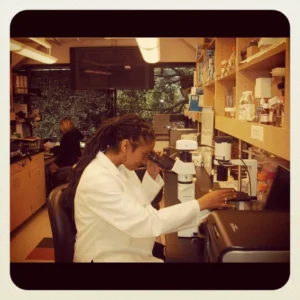
RB: I don’t think it was a typical academic trajectory. The Center wasn’t started by sociologists; it was started through a collaboration between an historian and a geneticist. Their goal was to bring together all kinds of people who were interested in the intersection between society and genetics.
So we had sociologists, we had anthropologists, we had people who were interested in communications, we had people in the genetics labs, and we had people doing clinical work. So it was a mix of people, but all of the people were focused on bringing their skill sets to bear on a shared set of questions.
It was really a great place to come up for air after grad school. And to think about what other disciplines have to teach me about approaching social problems.
At UCLA, I started working with colleagues on genomics and how it was being incorporated in to the public health infrastructures of so-called developing countries. Different nations are passing legislation to support genomics research and to build scientific capacity, and I’m studying that process with a similar set of questions that I applied to the stem cell initiative. Who’s included? Who’s excluded? And what assumptions about populations are built in to the science?
SCI: Can you tell me more about that project and about that genomics research workshop you went to in South Africa?
RB: Sure. This was a workshop that happened over a few days in Kimberley, South Africa with the country’s top genome researchers and representatives of indigenous councils who had experienced a number of problems with researchers in the past.
The scientists in South Africa were interested in talking with the councils and asking [the indigenous people] what would be meaningful for them in terms of contributing to the research, both in terms of preventing harms but also in terms of creating benefits for the community. Some benefits might be financial but others might be about members of these indigenous communities being trained to work on the science.
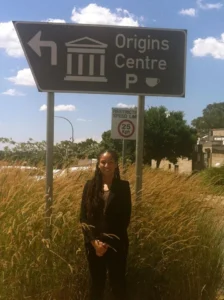 At the workshop the researchers were sharing genetics 101-type lectures, and the councils shared their knowledge of healthcare and what they had experienced in the past. Prayers and songs were very much a part of this workshop.
At the workshop the researchers were sharing genetics 101-type lectures, and the councils shared their knowledge of healthcare and what they had experienced in the past. Prayers and songs were very much a part of this workshop.
You don’t normally think of scientific workshops as including prayers and songs, but part of shifting the conversation is about letting people who are asked to “come to the table” shape what’s on the menu.
They need to be able to say, “We want this, but we don’t want this.” I think that requires scientists to go slower than they may want and to expect the conversation to stray from the official agenda that [the researchers] set.
It was very clear from the councils’ point of view that they were interested not only in gaining scientific knowledge in order to exercise truly informed consent. But they also wanted the prerogative to exercise what I call “informed refusal”. There was this idea that “Even after knowing all of this [scientific information], I might not come to the same conclusion as you. I might not want to participate or might not think that this is best for my community. We may choose to opt out.”
And while, technically, people always have this option, there are all kinds of reasons why they may feel pressured to participate or may be looked down upon by the research community as “just not getting it” if they decide to opt out.
SCI: What do you think scientists can do to address that?
RB: I think one of the biggest things is not to view the kinds of questions that sociologists and anthropologists ask as “contaminants” to what they’re doing.
When I use the metaphor about “science in a bubble,” I’m really thinking “How can what you do be made stronger by the kinds of social and political issues that we’re raising?”
That said, I don’t feel it’s my responsibility to convince them. [Scientists] really have to do the work of thinking, “What are the gaps in my knowledge?” Researchers are so used to providing answers to other people; it’s hard to go back and think “Okay. What can the people in other social spaces and in other academic disciplines contribute to what we know?”
SCI: What do you think about the MCAT deciding to add a social science component?
RB: They’re starting it in January, right? I’ve run into prospective medical students who are rushing madly to get it in before that time. Even those who are very sympathetic and interested in sociology are apprehensive about the new section, because they already have so many other things they have to know for the test.
The other thing is that unless medical education itself is transformed, I don’t know how much [adding social sciences to the MCAT] is going to matter. Just changing the entry point of the test without changing medical training probably isn’t going to have the impact that its designers are hoping for.
SCI: Circling back to teaching, how do you go about introducing these interdisciplinary concepts in the context of a sociology class?
RB: One of the classes I teach is called Science, Race, & Society. And I think in all of my classes, even the ones that aren’t about science — like some are focused more on race and ethnicity — all have a historical sensibility. It becomes more intuitive and easier to ask questions about the present if we have a better version of the past.
Unfortunately, the stories we tell ourselves about what science was are this “bubble version” of knowledge production that’s insulated from society. Part of what I want my students to understand is that science was always a social enterprise, and that it has always been shaped by social hierarchies.
So when you get a different origin story of science, then you can begin to see elements of the social story in the present and ask questions about how you want it to be in the future.
SCI: I think one of the things that really struck me from hearing you speak previously is that without very many people in the scientific community realizing it, the diseases that tend to be more prevalent in underserved communities tend to be further down on the research agenda. What do you think can be done about that issue?
RB: In terms of stem cell research, I’m sympathetic to the idea that early on, people want to follow the most promising science without necessarily thinking about the downstream translational aspects of which diseases it’s going to be used to treat and who it’s going to affect.
I don’t know that imposing specific diseases for basic researchers to focus on is a solution.
At the same time, I saw firsthand how many researchers’ passion about their work stemmed from some personal experience with the illness they hoped their work would impact. Life scientists, like all researchers, ask questions about problems that they see and experience. So it’s important to expand the range of experiences that scientists draw upon, and an obvious way to do this is to include a diverse array of people in producing knowledge.
In terms of research agendas, another issue I’m concerned about is the promises made in order to get people to sign on as study participants. This came to a head in the case of the Havasupai Indians who thought they were signing on for diabetes research that plagued their community, and they found out later their samples were used to study schizophrenia among other things.
The gap between how researchers present their work to the public — capital “S” science — and what they actually do in their day-to-day work — lower case “s” science — is one of the major things we need to address.
To learn more about Ruha Benjamin and her work, check out her website at http://www.ruhabenjamin.com/. Page header image from Wikimedia at File:Ruha Benjamin, Databite 124, 2019.jpg – Wikimedia Commons (licensed CC-BY).
Diana Crow is a freelance science writer. For more articles by Diana, visit her website at dianacrowscience.com or follow her at@CatalyticRxn on Twitter.